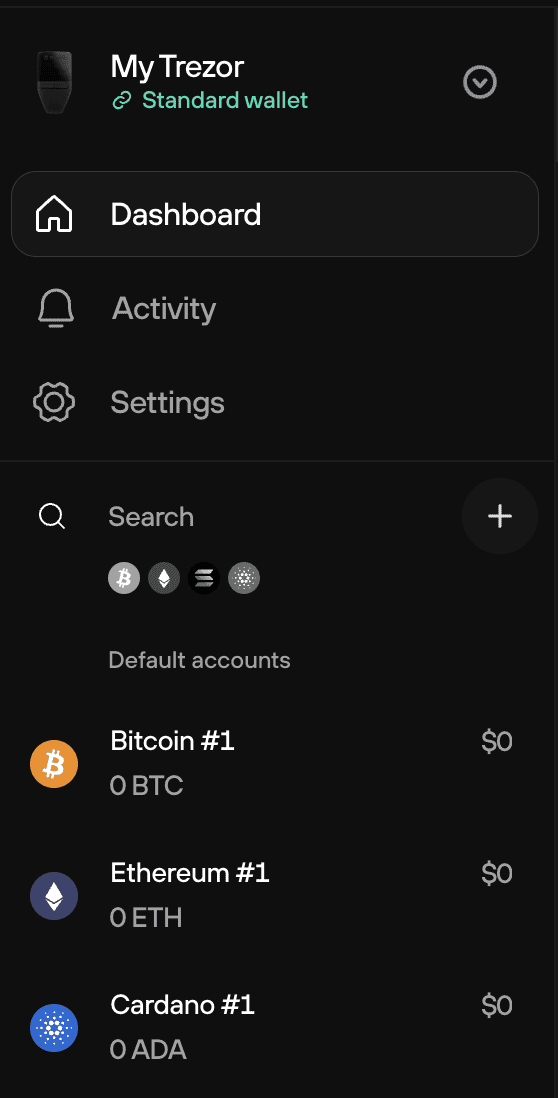Multiple accounts in Trezor Suite
For each supported cryptocurrency, Trezor Suite allows you to manage multiple accounts. This functionality makes it easier to track balances and manage your cryptocurrency identity. To enhance the privacy of your transactions, you can use multiple accounts, each with a specific purpose.
Accounts each have their own unique extended public key (XPUB) or public receiving address. Knowing an XPUB makes it possible to see all transactions to and from an account, so using multiple accounts protects this sensitive information.
Keep in mind that if you frequently send funds between two accounts, it may become clear that you are the owner of both. For this reason, using multiple accounts as an extra privacy feature is better suited to more advanced users.

Creating a new account
Creating a new account is easy. In Trezor Suite, press the plus sign next to My accounts and choose the coin you wish to work with. Some cryptocurrencies, such as Bitcoin, offer different address types, so you will need to specify this before proceeding.
Confirm the new account, and it will be created and appear in the sidebar. Now you can work with the new account.
In Trezor Suite, you will not be able to add a new account unless the previous one is used, i.e., you cannot create multiple empty accounts.
To send funds between your accounts, send a transaction from one account using the receiving address of the other.
A closer look at account types
Bitcoin addresses come in various types, including Taproot, Segwit, Legacy Segwit, and Legacy. It's essential to know how to identify a valid address and which address type to use when sending and receiving Bitcoin in Trezor Suite.
The different types of Bitcoin addresses are mostly cross-compatible, meaning you can send from any one type to another.
Bitcoin address types
- Segwit addresses (P2WPKH) are encoded using Bech32 and start with bc1q. Trezor Suite defaults to using Segwit addresses as they are more efficient than older address types. A Segwit Bech32 address has 42 characters.
- Taproot is the newest upgrade to Bitcoin introduced in November 2021. It uses the P2TR (pay-to-Taproot) address format that begins with bc1p. These addresses offer lower fees and improved privacy. A Taproot Bech32m address has 62 characters.
- Legacy Segwit addresses (P2SH-P2WPKH) are hybrid versions of Segwit that can be read as both a pay to script hash (P2SH) and a pay to witness key hash (P2WPKH). These addresses begin with the number 3 and can be more efficient than legacy addresses. A Legacy Segwit P2SH-P2WPKH address encoded in base 58 has 34 characters.
- Legacy addresses (P2PKH) are older address types that start with the number 1. These are still common but tend to have higher transaction fees. A Legacy P2PKH address has 34 characters.
For more information about the different types of Bitcoin accounts, check out our blog post: Bitcoin addresses and how to use them.
Other coins, such as Litecoin, also have multiple account types. Ensure you have selected the correct account type when creating a new one.
Account limits in Trezor Suite
In Trezor Suite, users can create 10 accounts per cryptocurrency per account type. This limitation helps decrease the load on the SatoshiLabs servers. However, the number of accounts supported by your Trezor device itself is not limited.
A new account can only be added if the preceding account is not empty.
Users can also create as many addresses as needed. However, due to the BIP-44 standard address gap limit, the number of fresh addresses is limited to 20.
If the software encounters 20 unused addresses in a row, it assumes there are no used addresses beyond this point and stops searching the address chain. Only external chains are scanned, as internal chains only receive coins from associated external chains.
If a new account (such as a second Bitcoin account) is added but not used, Trezor Suite will not save the account when restarted.
For example, Bitcoin currently has four distinct account types:
- Taproot (P2TR)
- Segwit (P2WPKH)
- Legacy Segwit (P2SH-P2WPKH)
- Legacy (P2PKH)
Up to 10 of each can be managed at once in Trezor Suite.